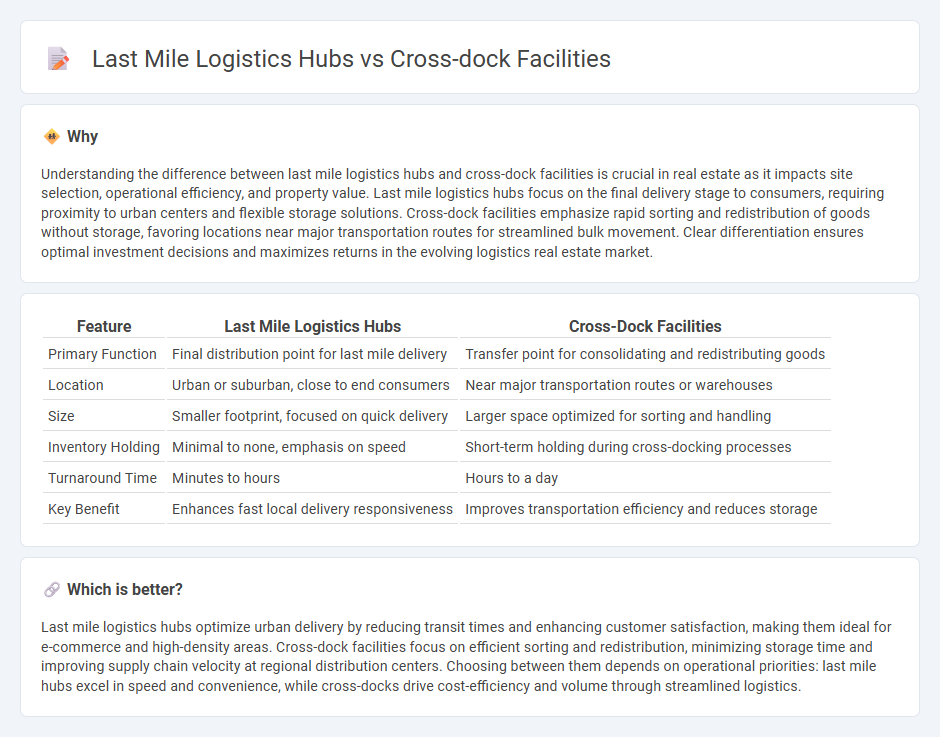
Last mile logistics hubs focus on speedy delivery to end consumers by placing distribution centers near urban areas, reducing transit time and shipping costs. Cross-dock facilities emphasize efficient transfer and sorting of goods between inbound and outbound trucks, minimizing storage time and handling expenses. Explore how these real estate models transform supply chain strategies and optimize logistics efficiency.
Why it is important
Understanding the difference between last mile logistics hubs and cross-dock facilities is crucial in real estate as it impacts site selection, operational efficiency, and property value. Last mile logistics hubs focus on the final delivery stage to consumers, requiring proximity to urban centers and flexible storage solutions. Cross-dock facilities emphasize rapid sorting and redistribution of goods without storage, favoring locations near major transportation routes for streamlined bulk movement. Clear differentiation ensures optimal investment decisions and maximizes returns in the evolving logistics real estate market.
Comparison Table
| Feature | Last Mile Logistics Hubs | Cross-Dock Facilities |
|---|---|---|
| Primary Function | Final distribution point for last mile delivery | Transfer point for consolidating and redistributing goods |
| Location | Urban or suburban, close to end consumers | Near major transportation routes or warehouses |
| Size | Smaller footprint, focused on quick delivery | Larger space optimized for sorting and handling |
| Inventory Holding | Minimal to none, emphasis on speed | Short-term holding during cross-docking processes |
| Turnaround Time | Minutes to hours | Hours to a day |
| Key Benefit | Enhances fast local delivery responsiveness | Improves transportation efficiency and reduces storage |
Which is better?
Last mile logistics hubs optimize urban delivery by reducing transit times and enhancing customer satisfaction, making them ideal for e-commerce and high-density areas. Cross-dock facilities focus on efficient sorting and redistribution, minimizing storage time and improving supply chain velocity at regional distribution centers. Choosing between them depends on operational priorities: last mile hubs excel in speed and convenience, while cross-docks drive cost-efficiency and volume through streamlined logistics.
Connection
Last mile logistics hubs are strategically located near urban areas to facilitate rapid delivery of goods, while cross-dock facilities act as intermediary points where shipments are quickly sorted and redirected without long-term storage. Both functions create synergies in real estate by optimizing supply chain efficiency, minimizing warehouse space requirements, and reducing transportation costs. Integrating these facilities within commercial real estate development enhances accessibility and supports high-demand urban distribution networks.
Key Terms
Throughput
Cross-dock facilities excel in maximizing throughput by rapidly sorting and transferring goods from inbound to outbound transportation, minimizing storage time and enabling high-volume processing. Last mile logistics hubs focus on efficiently managing smaller, frequent deliveries to end customers, optimizing route planning and delivery speed rather than bulk transfer capacity. Explore detailed comparisons to understand how throughput impacts operational efficiency in these critical logistics nodes.
Proximity
Cross-dock facilities optimize inventory flow by minimizing storage time through direct transfer between inbound and outbound shipments, usually located near major transportation arteries for efficient throughput. Last mile logistics hubs prioritize proximity to final delivery destinations, enabling faster, cost-effective shipments in densely populated urban areas. Explore how strategic location choices impact supply chain efficiency and customer satisfaction.
Turnaround time
Cross-dock facilities streamline loading and unloading processes, significantly reducing turnaround time by minimizing storage duration and enabling rapid transfer of goods between inbound and outbound transportation. Last mile logistics hubs optimize final delivery routes, enhancing speed and efficiency in meeting the end customer's demand within tight time windows. Explore how integrating both systems can transform your supply chain's turnaround time for superior operational performance.
Source and External Links
Understanding Cross-Docking: A Comprehensive Guide - This webpage provides insights into cross-docking, including best practices for facility design, dock door placement, and operational efficiency.
How Does Cross Docking Work in Industrial Real Estate? - This article explains how cross-dock facilities are designed to reduce costs and improve efficiency by quickly moving goods from one loading dock to another.
How Cross-Dock Warehouses Work: Guide To Cross-Dock - This guide details the benefits and operation of cross-dock warehouses, including minimal storage costs and speedy operations to enhance supply chain efficiency.
 dowidth.com
dowidth.com